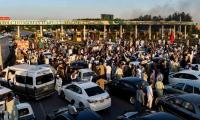The results of the general elections held on February 8 have once again shown that political engineering before or during elections does not help the country or its democracy, which has remained nascent throughout Pakistan’s existence of 77 years.
Such engineering is even more harmful if done after the elections to install a government that does not command the public mandate. In simple words, political engineering may refer to any attempt to design a certain political outcome in society. In the process we see certain institutions going beyond the pale of their original responsibility in society to achieve some desired results.
This is an old story that deserves retelling so that we can understand why most elections in Pakistan became the chronicles of an election foretold. Such political engineering in Pakistan started immediately after Independence, resulting in the delayed formulation of the first constitution in 1956. This prevented any general elections for over a decade.
But even after the promulgation of the first constitution, political engineering continued, mainly stemming from the President House which became an embodiment of shenanigans by the civil and military bureaucracy. Per the 1956 constitution, the country had to go through its first general elections to install a popularly elected government. The people of East Pakistan (now Bangladesh) defeated the Muslim League in provincial elections and in the next general elections parties such as the Awami League (AL) and the National Awami Party (NAP) were poised to win a majority. Alas, that was not acceptable to the President House and all that it represented.
First, they kept postponing elections and then an outright martial law became the destiny of this nation in 1958. But no political engineering has been able to wipe out the parties that command the support of the people. Chief Martial Law Administrator (CMLA) General Ayub Khan ruled with an iron hand for 11, and during that period, all elections – be it for ‘basic democracy’ (local bodies), for assemblies, or to elect the president himself – were far from being transparent. Political parties became a target of suppression but they survived, much to the chagrin of the manipulators.
The ambition to obtain certain desired results is a hallmark of all political engineering. The 1960s witnessed arm-twisting, bribery, corruption, and direct interventions by state machinery to divert the political stream to a preferred direction. After 11 years of dictatorship, General Ayub Khan realized that all his attempts were in vain as the people of Pakistan were not ready to forsake their aspirations for democracy in the country. Sensing the turning tide, General Yahya Khan eased him out to usurp power directly as another CMLA and self-appointed president.
Another general election could have given the country its first elected prime minister but the results of those elections were too good to accept. The refusal to follow the results had dire consequences for the country, which ended up losing its eastern wing that ultimately emerged as an independent country – Bangladesh.
The military action in East Pakistan led to the death of a united country for sure. All major political parties survived because they had the support of the people; the military dictatorship of General Yahya Khan could not.
In the 1970s, Pakistan witnessed another general election amid a usual crackdown on the opposition as the largest opposition party – the NAP – found itself banned and its leadership in jail. The results of the 1977 elections reflected another political engineering that derailed democracy once again. General Ziaul Haq’s military takeover and the subsequent judicial murder of ZA Bhutto did tremendous harm to democracy and politics. For another 11 years, General Zia looked for his desired results which he dubbed ‘musbat nataij’ (positive results). He kept postponing elections because he wanted just the ‘positive results’ that could keep him in power forever.
Eleven years of political engineering by constitutional mutilations, press censorships, and severe crackdown on political activists, journalists and leaders could not produce the results Gen Zia wanted. And after his death, the PPP did manage to win elections despite all the manipulations by Gen Zia’s successors. Once again the President House became a centre of activities that looked more like conspiracies against civilian supremacy and democracy in the country. The 1990s also witnessed the repeated removals of prime ministers just to obtain some ‘positive results’ – in the words of Gen Zia who was no more around but his legacy survived.
By the turn of the century, the country was under yet another military dictatorship. Gen Musharraf assumed power and aimed for similar results that his predecessors repeatedly tried to obtain at the cost of political stability. The 2002 elections became another example of political engineering, which reminded people of the tactics that Ayub Khan, Yahya Khan and Ziaul Haq had used but repeatedly failed. More than two decades later, the Supreme Court of Pakistan has now declared Gen Musharraf a usurper by upholding his death sentence; may his soul rest in peace.
The story of the past 16 years is, in one way or the other, a continuation of the same chronicles. But the credit is due to General Ashfaq Parvez Kayani who by and large did not target any political party during his six years as the army chief. He did manage to get an extension and served for two terms but overall his tenure did not meddle in the two general elections of 2008 and 2013.
Both elections brought to power two different political parties: the PPP and PML-N which managed to complete their terms in office though their prime ministers lost their offices by the orders of the Supreme Court.
It does not mean that the second decade of the 21st century did not see any political engineering. The story of the PTI and its rise to power is well known now. A leader who commanded little or no support in 2010 suddenly emerged as a rising star of Pakistani politics, and it was not his hard work alone. The 2016 to 2022 period was replete with attempts to obtain ‘positive results’.
Now the election results of 2024 have once again displayed the point in clear terms that once a political party manages to earn public support, it is hard to wipe that party out. Be it General Zia’s party-less elections of 1985 or independent candidates winning in 2024, all prove that the people of Pakistan do not like political engineering – direct or indirect. We all remember the way the last Senate elections witnessed the turncoats change their loyalties. Observers should now look at the election results and see how they may or may not turn into ‘positive results’.
The overwhelming number of independent candidates winning on Feb 8 is a testimony to the desire of the electorate to forestall any ‘positive results’ if they stem from any political engineering. The people of Pakistan have spoken in no uncertain terms that only they have the right to decide who to vote for. Even those who do not have any sympathy left for the PTI or its leaders are against the highhandedness on display lately. People do not want to engage in manufactured elections anymore. Let it be a fair game, and the players must also steer clear of any foul play.
The writer holds a PhD from the University of Birmingham, UK. He tweets/posts @NaazirMahmood and can be reached at: mnazir1964@yahoo.co.uk
Data, today, defines how we make decisions with tools allowing us to analyse experience more precisely
But if history has shown us anything, it is that rivals can eventually unite when stakes are high enough
Imagine a classroom where students are encouraged to question, and think deeply
Pakistan’s wheat farmers face unusually large pitfalls highlighting root cause of downward slide in agriculture
In agriculture, Pakistan moved up from 48th rank in year 2000 to an impressive ranking of 15th by year 2023
Born in Allahabad in 1943, Saeeda Gazdar migrated to Pakistan after Partition







